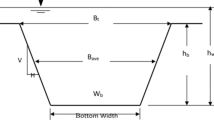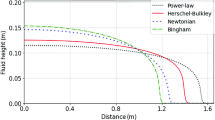Abstract
Dam break flows have been a focus of attention for a long in the hydraulic engineering discipline. The interest stems from their high hazard potential to human life and property. This research investigates a laboratory dam break flow using a 3D Reynolds-averaged Navier–Stokes (RANS) and a 2D shallow water Eq. (2D SWE) model. The two numerical models have been compared to measured data regarding flow depth, streamwise surface flow velocity, and point velocity. The results show that as far as a simulation of water depths at gauging stations is concerned, both models are almost at par with an error of about 20% of the mean depth value. Further, the comparison of surface velocity field reveals that though both models are capable of reproducing the salient flow features, e.g., oblique hydraulic jump, wake, etc., the 3D RANS model is more accurate in predicting the jump length and the so-called wet–dry fronts. The important contribution of this research lies in clearly enunciating the tradeoffs between a 2D SWE model and a 3D RANS model. The former model is computationally efficient and accurate as far as flow depth and velocity are concerned while the latter model provides a more complete result output, e.g., vertical flow velocity, turbulent kinetic energy and turbulent dissipation, etc. However, for obtaining significant accuracy with a 3D model a more accurate turbulence model than RANS is required which necessitate usage of very refined mesh (~ mm), thus, raising the cost of the simulation manifold.











Similar content being viewed by others
References
Haider, S.; Gabriel, H.F.; Khan, S.A.: SuperCritical flow simulation at a right channel junction. Comparison between a uniform and sparse m–esh. KSCE J. Civ. Eng. 21, 2984–2990 (2017). https://doi.org/10.1007/s12205-017-0811-7
Shige-eda, M.; Akiyama, J.: Numerical and experimental study on two-dimensional flood flows with and without structures. J. Hydraul. Eng. 129(10), 817–821 (2003)
Haider, S.; Paquier, A.; Morel, R.; Champagne, J.Y.: Urban flood modelling using computational fluid dynamics. Proc. Inst. Civ. Eng. UK J. Water Marit. Eng. 156, 129–135 (2003)
Abderrezzak, K.E.; Paquier, A.: Modelling flash flood propagation in urban areas using a two-dimensional numerical model. Nat. Hazards 50, 433–460 (2009)
Haider, S.; Saeed, U.; Shahid, M.: 2D numerical modelling of two dam-break flood studies in an urban locality. Arab. J. Geosci. (2020). https://doi.org/10.1007/s12517-020-05709-9
Larocque, A.L.; Imran, J.; Chaudhry, M.H.: 3D numerical simulation of partial breach dam-break flow using the LES and κ-ε turbulence models. J. Hydraul. Res. 51(2), 145–157 (2013). https://doi.org/10.1080/00221686.2012.734862
Kamath, A.; Fleit, G.; Bihs, H.: Investigation of free surface turbulence damping in RANS simulations for complex free surface flows. Water 11, 456–481 (2019). https://doi.org/10.3390/w11030456
Langhi, M.; Hosoda, T.; Dey, S.: Analytical solution of κ-ε model for non-uniform flows. J. Hydraul. Eng. (2018). https://doi.org/10.1061/(ASCE)HY.1943-7900.0001472
Soares-Frazao, S.; Zech, Y.: Experimental study of dam-break flow against an isolated obstacle. J. Hydraul. Res. 45(sup1), 27–36 (2007). https://doi.org/10.1080/00221686.2007.9521830
Ozmen-Cagatay, H.; Kocaman, S.: Dam-break flow in the presence of obstacle: experiment and CFD simulation. Eng. Appl. Comput. Fluid Mech. 5(4), 541–552 (2011). https://doi.org/10.1080/19942060.2011.11015393
Weller, H.; Tabor, G.; Jask, H.; Fureby, C.: A tensorial approach to computational continuum mechanics using object-oriented techniques. Comput. Phys. 12, 620–631 (1998)
Hirt, C.; Nichols, B.: Volume of fluid (VOF) method for the dynamics of free boundaries. J. Comput. Phys. 39, 201–225 (1981)
Ubbink, O.; Numerical Prediction of Two Fluid Systems with Sharp Interfaces. Dissertation, Imperial College of Science, Technology and Medicine, UK (1997)
Berberovic, E.; Investigation of free-surface flow associated with drop impact: numerical simulations and theoretical modeling. Dissertation, Imperial College of Science, Technology and Medicine, UK (2010)
Vetsch, D.; Siviglia, A.; Caponi, F.; Ehrbar, D.; Gerke, E.; Kammerer, S.; Koch, A; Peter, S.; Vanzo, D.; Vonwiller, L.; Facchini, M.; Gerber, M.; Volz, C.; Farshi, D.; Mueller, R.; Rousselot, P.; Veprek, R.; Faeh, R.: System Manuals of Basement Version 2.8. Laboratory of Hydraulics, Hydrology and Glacialogy (VAW), ETH Zurich (2018). http://www.basement.ethz.ch. Accessed 24 May 2022
Biswas, R.; Strawn, R.C.: Tetrahedral and hexahedral mesh adaptation for CFD problems. Appl. Numer. Math. 26(1–2), 135–151 (1998). https://doi.org/10.1016/S0168-9274(97)00092-5
Hirsch, C.: Numerical Computation of Internal and External Flows: the Fundamentals of Computational Fluid Dynamics. Butterworth-Heinemann (2007)
Bayon, A.; Valero, D.; Garcia-Bartual, R., et al.: Performance assessment of OpenFOAM and Flow-3D in the numerical modeling of a low Reynolds number hydraulic jump. Environ Model Softw. 80, 322–335 (2016)
Zedler, E.; Street, R.L.: Large-eddy simulation of sediment transport: currents over ripples. J. Hydraul. Eng. 127(6), 444–452 (2001)
Fischer-Antze, T.; Rüther, N.; Olsen, N.R.B.; Gutknecht, D.: Three-dimensional (3D) modeling of nonuniform sediment transport in a channel bend with unsteady flow. J. Hydraul. Res. 47, 670–675 (2009). https://doi.org/10.3826/jhr.2009.3252
Schlichting, H.; Gersten, K.: Boundary-layer Theory. Springer (2000)
Wilcox, D.: Turbulence Modeling for CFD. DCW Industries, La Canada, California, USA (1998)
Pope, S.B.: Turbulent Flows. Cambridge University Press, Cambridge (2000)
Celik, I.B.; Ghia, U.; Roache, P.J.: Procedure for estimation and reporting of uncertainty due to discretization in CFD applications. ASME J Fluids Eng 130, 1–4 (2008)
Shigematsu, T.; Liu, P.L.-F.: Numerical modelling of the initial stages of dam-break waves. J. Hydraul. Res. 42(2), 183–195 (2010). https://doi.org/10.1080/00221686.2004.9628303
Cea, L.; Puertas, J.; Vazquez-Cendon, M.E.: Depth-averaged modeling of turbulent shallow water flow with wet-dry fronts. Arch. Comput. Methods Eng. 14, 303–341 (2007). https://doi.org/10.1007/s11831-007-9009-3
Alcrudo, F.; Garcia, P.; Brufau, P.; Murillo, J; Garcia, D.; Mulet, J.; Testa, G.; Zuccala, D.: The model city flooding experiment. http://www.impact-project.net/AnnexII_DetailedTechnicalReports/AnnexII_PartB_WP3/Model_City_Flooding_Experiment.pdf (2005). Accessed 13 July 2019
Ingram, R.G.; Chu, V.H.: Flow around islands in Rupert Bay: an investigation of the bottom friction effects. AGU Oceans 92, 14521–14533 (1987)
Chen, D.; Jirka, G.H.: Experimental study of plane turbulent wakes in shallow water layers. Fluid Dyn. Res. 16, 11–41 (1995)
Acknowledgements
We extend our gratitude to State Key Laboratory of Water Resources and Hydropower Engineering Science, Wuhan University, China for funding this research through Project grant No. 2020SD01.
Author information
Authors and Affiliations
Corresponding author
Rights and permissions
Springer Nature or its licensor (e.g. a society or other partner) holds exclusive rights to this article under a publishing agreement with the author(s) or other rightsholder(s); author self-archiving of the accepted manuscript version of this article is solely governed by the terms of such publishing agreement and applicable law.
About this article
Cite this article
Haider, S., Gabriel, H.F., Yang, L. et al. Dam Break Flow: A Comparative Model Study Using OpenFOAM and BASEMENT. Arab J Sci Eng 49, 5385–5401 (2024). https://doi.org/10.1007/s13369-023-08400-9
Received:
Accepted:
Published:
Issue Date:
DOI: https://doi.org/10.1007/s13369-023-08400-9




